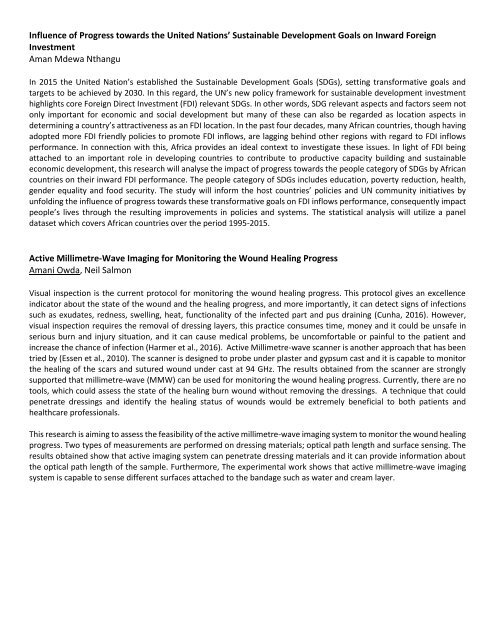Conference Programme FULL (1)
You also want an ePaper? Increase the reach of your titles
YUMPU automatically turns print PDFs into web optimized ePapers that Google loves.
Influence of Progress towards the United Nations’ Sustainable Development Goals on Inward Foreign<br />
Investment<br />
Aman Mdewa Nthangu<br />
In 2015 the United Nation’s established the Sustainable Development Goals (SDGs), setting transformative goals and<br />
targets to be achieved by 2030. In this regard, the UN’s new policy framework for sustainable development investment<br />
highlights core Foreign Direct Investment (FDI) relevant SDGs. In other words, SDG relevant aspects and factors seem not<br />
only important for economic and social development but many of these can also be regarded as location aspects in<br />
determining a country’s attractiveness as an FDI location. In the past four decades, many African countries, though having<br />
adopted more FDI friendly policies to promote FDI inflows, are lagging behind other regions with regard to FDI inflows<br />
performance. In connection with this, Africa provides an ideal context to investigate these issues. In light of FDI being<br />
attached to an important role in developing countries to contribute to productive capacity building and sustainable<br />
economic development, this research will analyse the impact of progress towards the people category of SDGs by African<br />
countries on their inward FDI performance. The people category of SDGs includes education, poverty reduction, health,<br />
gender equality and food security. The study will inform the host countries’ policies and UN community initiatives by<br />
unfolding the influence of progress towards these transformative goals on FDI inflows performance, consequently impact<br />
people’s lives through the resulting improvements in policies and systems. The statistical analysis will utilize a panel<br />
dataset which covers African countries over the period 1995-2015.<br />
Active Millimetre-Wave Imaging for Monitoring the Wound Healing Progress<br />
Amani Owda, Neil Salmon<br />
Visual inspection is the current protocol for monitoring the wound healing progress. This protocol gives an excellence<br />
indicator about the state of the wound and the healing progress, and more importantly, it can detect signs of infections<br />
such as exudates, redness, swelling, heat, functionality of the infected part and pus draining (Cunha, 2016). However,<br />
visual inspection requires the removal of dressing layers, this practice consumes time, money and it could be unsafe in<br />
serious burn and injury situation, and it can cause medical problems, be uncomfortable or painful to the patient and<br />
increase the chance of infection (Harmer et al., 2016). Active Millimetre-wave scanner is another approach that has been<br />
tried by (Essen et al., 2010). The scanner is designed to probe under plaster and gypsum cast and it is capable to monitor<br />
the healing of the scars and sutured wound under cast at 94 GHz. The results obtained from the scanner are strongly<br />
supported that millimetre-wave (MMW) can be used for monitoring the wound healing progress. Currently, there are no<br />
tools, which could assess the state of the healing burn wound without removing the dressings. A technique that could<br />
penetrate dressings and identify the healing status of wounds would be extremely beneficial to both patients and<br />
healthcare professionals.<br />
This research is aiming to assess the feasibility of the active millimetre-wave imaging system to monitor the wound healing<br />
progress. Two types of measurements are performed on dressing materials; optical path length and surface sensing. The<br />
results obtained show that active imaging system can penetrate dressing materials and it can provide information about<br />
the optical path length of the sample. Furthermore, The experimental work shows that active millimetre-wave imaging<br />
system is capable to sense different surfaces attached to the bandage such as water and cream layer.


